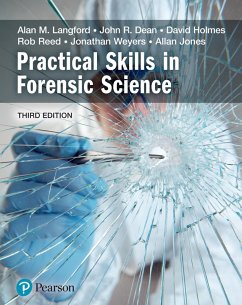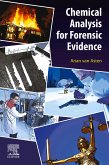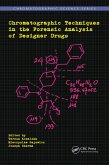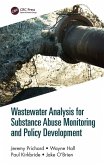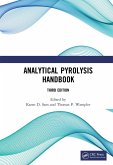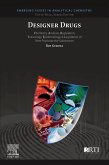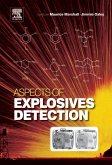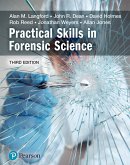Alan M Langford, John Dean, Rob Reed, Jonathan Weyers, David A Holmes
Practical Skills in Forensic Science (eBook, ePUB)
42,95 €
42,95 €
inkl. MwSt.
Sofort per Download lieferbar

21 °P sammeln
42,95 €
Als Download kaufen

42,95 €
inkl. MwSt.
Sofort per Download lieferbar

21 °P sammeln
Jetzt verschenken
Alle Infos zum eBook verschenken
42,95 €
inkl. MwSt.
Sofort per Download lieferbar
Alle Infos zum eBook verschenken

21 °P sammeln
Alan M Langford, John Dean, Rob Reed, Jonathan Weyers, David A Holmes
Practical Skills in Forensic Science (eBook, ePUB)
- Format: ePub
- Merkliste
- Auf die Merkliste
- Bewerten Bewerten
- Teilen
- Produkt teilen
- Produkterinnerung
- Produkterinnerung

Bitte loggen Sie sich zunächst in Ihr Kundenkonto ein oder registrieren Sie sich bei
bücher.de, um das eBook-Abo tolino select nutzen zu können.
Hier können Sie sich einloggen
Hier können Sie sich einloggen
Sie sind bereits eingeloggt. Klicken Sie auf 2. tolino select Abo, um fortzufahren.

Bitte loggen Sie sich zunächst in Ihr Kundenkonto ein oder registrieren Sie sich bei bücher.de, um das eBook-Abo tolino select nutzen zu können.
Practical Skills in Forensic Science
- Geräte: eReader
- ohne Kopierschutz
- eBook Hilfe
Andere Kunden interessierten sich auch für
![Chemical Analysis for Forensic Evidence (eBook, ePUB) Chemical Analysis for Forensic Evidence (eBook, ePUB)]() Arian van AstenChemical Analysis for Forensic Evidence (eBook, ePUB)95,95 €
Arian van AstenChemical Analysis for Forensic Evidence (eBook, ePUB)95,95 €![Chromatographic Techniques in the Forensic Analysis of Designer Drugs (eBook, ePUB) Chromatographic Techniques in the Forensic Analysis of Designer Drugs (eBook, ePUB)]() Chromatographic Techniques in the Forensic Analysis of Designer Drugs (eBook, ePUB)47,95 €
Chromatographic Techniques in the Forensic Analysis of Designer Drugs (eBook, ePUB)47,95 €![Wastewater Analysis for Substance Abuse Monitoring and Policy Development (eBook, ePUB) Wastewater Analysis for Substance Abuse Monitoring and Policy Development (eBook, ePUB)]() Jeremy PrichardWastewater Analysis for Substance Abuse Monitoring and Policy Development (eBook, ePUB)45,95 €
Jeremy PrichardWastewater Analysis for Substance Abuse Monitoring and Policy Development (eBook, ePUB)45,95 €![Analytical Pyrolysis Handbook (eBook, ePUB) Analytical Pyrolysis Handbook (eBook, ePUB)]() Analytical Pyrolysis Handbook (eBook, ePUB)56,95 €
Analytical Pyrolysis Handbook (eBook, ePUB)56,95 €![Designer Drugs (eBook, ePUB) Designer Drugs (eBook, ePUB)]() Roy GeronaDesigner Drugs (eBook, ePUB)57,95 €
Roy GeronaDesigner Drugs (eBook, ePUB)57,95 €![Aspects of Explosives Detection (eBook, ePUB) Aspects of Explosives Detection (eBook, ePUB)]() Aspects of Explosives Detection (eBook, ePUB)113,95 €
Aspects of Explosives Detection (eBook, ePUB)113,95 €![Practical Skills in Forensic Science (eBook, PDF) Practical Skills in Forensic Science (eBook, PDF)]() Alan M LangfordPractical Skills in Forensic Science (eBook, PDF)41,95 €
Alan M LangfordPractical Skills in Forensic Science (eBook, PDF)41,95 €-
-
-
Practical Skills in Forensic Science
Dieser Download kann aus rechtlichen Gründen nur mit Rechnungsadresse in A, B, BG, CY, CZ, D, DK, EW, E, FIN, F, GR, HR, H, IRL, I, LT, L, LR, M, NL, PL, P, R, S, SLO, SK ausgeliefert werden.
Produktdetails
- Produktdetails
- Verlag: Pearson HigherEducation
- Seitenzahl: 1
- Altersempfehlung: ab 18 Jahre
- Erscheinungstermin: 4. Januar 2019
- Englisch
- ISBN-13: 9781292140506
- Artikelnr.: 54930937
- Verlag: Pearson HigherEducation
- Seitenzahl: 1
- Altersempfehlung: ab 18 Jahre
- Erscheinungstermin: 4. Januar 2019
- Englisch
- ISBN-13: 9781292140506
- Artikelnr.: 54930937
- Herstellerkennzeichnung Die Herstellerinformationen sind derzeit nicht verfügbar.
ALAN LANGFORD is Senior Lecturer and Programme Leader in Criminology and Forensic Sciences at Northumbria University, UK; JOHN DEAN is Professor of Analytical and Environmental Sciences and Director of the Graduate School at Northumbria University, UK; ROB REED is Professor of Biomedical Science and Director of Undergraduate Science Programs at CQUniversity, Australia; DAVID HOLMES is Director of Collaborative Programs in Applied Sciences at Northumbria University, UK; JONATHAN WEYERS is Director of Quality Assurance at the University of Dundee, UK; and ALLAN JONES is Senior Lecturer and Chancellor's Award Fellow in Ecology, Environmental Science and Zoology at the University of Dundee, UK.
1 Essentials of practical work
2 Health and safety
3 Making measurements and observations
4 SI units and their use
5 Scientific method and design of experiments
6 Working with liquids
7 Basic laboratory procedures
8 Principles of solution chemistry
9 pH and buffer solutions
10 Introduction to microscopy
11 Setting up and using microscopes
12 Sample preparation
13 DNA analysis – fundamental principles
14 Chromatography
15 Mass spectrometry
16 Basic spectroscopy
17 Atomic spectroscopy
18 X-ray fluorescence spectroscopy
19 Infrared and Raman spectroscopy
20 Nuclear magnetic resonance spectroscopy
21 Immunoassay
22 Electrophoresis
23 Personnel and recording the scene
24 Collecting evidence – basic principles
25 Digital evidence
26 Investigating fingerprints
27 Footwear marks and impressions
28 Investigating other marks
29 Document analysis
30 Analysis of biological fluids
31 DNA analysis – forensic applications
32 Analysis of hair
33 Analysis of skeletal remains
34 Forensic odontology
35 Forensic entomology
36 Forensic botany
37 Alcohol analysis
38 Forensic toxicology
39 Bulk drug analysis
40 Analysis of paint
41 Analysis of glass
42 Analysis of fibres
43 Firearms and ballistic evidence
44 Analysis of fires and explosions
45 Finding and citing published information
46 Using online resources
47 Evaluating information
48 Word processors, databases and other packages
49 Using Spreadsheets
50 Fundamental principles of quantitative chemical analysis
51 Calibration and quantitative analysis
52 Using graphs
53 Presenting data in tables
54 Hints for solving numerical problems
55 Descriptive statistics
56 Choosing and using statistical tests
57 Chemometrics and advanced statistics
58 General aspects of scientific writing
59 Giving a spoken presentation
60 Writing a forensic statement and presenting evidence in court
61 Reporting practical and project work
62 Writing essays, literature surveys and reviews
63 Organising a poster display
64 The importance of transferable skills
65 Managing your time
66 Working with others
67 Taking notes from lectures and texts
68 Learning and revising effectively
69 Assessments and exams
70 Preparing your curriculum vitae
2 Health and safety
3 Making measurements and observations
4 SI units and their use
5 Scientific method and design of experiments
6 Working with liquids
7 Basic laboratory procedures
8 Principles of solution chemistry
9 pH and buffer solutions
10 Introduction to microscopy
11 Setting up and using microscopes
12 Sample preparation
13 DNA analysis – fundamental principles
14 Chromatography
15 Mass spectrometry
16 Basic spectroscopy
17 Atomic spectroscopy
18 X-ray fluorescence spectroscopy
19 Infrared and Raman spectroscopy
20 Nuclear magnetic resonance spectroscopy
21 Immunoassay
22 Electrophoresis
23 Personnel and recording the scene
24 Collecting evidence – basic principles
25 Digital evidence
26 Investigating fingerprints
27 Footwear marks and impressions
28 Investigating other marks
29 Document analysis
30 Analysis of biological fluids
31 DNA analysis – forensic applications
32 Analysis of hair
33 Analysis of skeletal remains
34 Forensic odontology
35 Forensic entomology
36 Forensic botany
37 Alcohol analysis
38 Forensic toxicology
39 Bulk drug analysis
40 Analysis of paint
41 Analysis of glass
42 Analysis of fibres
43 Firearms and ballistic evidence
44 Analysis of fires and explosions
45 Finding and citing published information
46 Using online resources
47 Evaluating information
48 Word processors, databases and other packages
49 Using Spreadsheets
50 Fundamental principles of quantitative chemical analysis
51 Calibration and quantitative analysis
52 Using graphs
53 Presenting data in tables
54 Hints for solving numerical problems
55 Descriptive statistics
56 Choosing and using statistical tests
57 Chemometrics and advanced statistics
58 General aspects of scientific writing
59 Giving a spoken presentation
60 Writing a forensic statement and presenting evidence in court
61 Reporting practical and project work
62 Writing essays, literature surveys and reviews
63 Organising a poster display
64 The importance of transferable skills
65 Managing your time
66 Working with others
67 Taking notes from lectures and texts
68 Learning and revising effectively
69 Assessments and exams
70 Preparing your curriculum vitae
1 Essentials of practical work
2 Health and safety
3 Making measurements and observations
4 SI units and their use
5 Scientific method and design of experiments
6 Working with liquids
7 Basic laboratory procedures
8 Principles of solution chemistry
9 pH and buffer solutions
10 Introduction to microscopy
11 Setting up and using microscopes
12 Sample preparation
13 DNA analysis – fundamental principles
14 Chromatography
15 Mass spectrometry
16 Basic spectroscopy
17 Atomic spectroscopy
18 X-ray fluorescence spectroscopy
19 Infrared and Raman spectroscopy
20 Nuclear magnetic resonance spectroscopy
21 Immunoassay
22 Electrophoresis
23 Personnel and recording the scene
24 Collecting evidence – basic principles
25 Digital evidence
26 Investigating fingerprints
27 Footwear marks and impressions
28 Investigating other marks
29 Document analysis
30 Analysis of biological fluids
31 DNA analysis – forensic applications
32 Analysis of hair
33 Analysis of skeletal remains
34 Forensic odontology
35 Forensic entomology
36 Forensic botany
37 Alcohol analysis
38 Forensic toxicology
39 Bulk drug analysis
40 Analysis of paint
41 Analysis of glass
42 Analysis of fibres
43 Firearms and ballistic evidence
44 Analysis of fires and explosions
45 Finding and citing published information
46 Using online resources
47 Evaluating information
48 Word processors, databases and other packages
49 Using Spreadsheets
50 Fundamental principles of quantitative chemical analysis
51 Calibration and quantitative analysis
52 Using graphs
53 Presenting data in tables
54 Hints for solving numerical problems
55 Descriptive statistics
56 Choosing and using statistical tests
57 Chemometrics and advanced statistics
58 General aspects of scientific writing
59 Giving a spoken presentation
60 Writing a forensic statement and presenting evidence in court
61 Reporting practical and project work
62 Writing essays, literature surveys and reviews
63 Organising a poster display
64 The importance of transferable skills
65 Managing your time
66 Working with others
67 Taking notes from lectures and texts
68 Learning and revising effectively
69 Assessments and exams
70 Preparing your curriculum vitae
2 Health and safety
3 Making measurements and observations
4 SI units and their use
5 Scientific method and design of experiments
6 Working with liquids
7 Basic laboratory procedures
8 Principles of solution chemistry
9 pH and buffer solutions
10 Introduction to microscopy
11 Setting up and using microscopes
12 Sample preparation
13 DNA analysis – fundamental principles
14 Chromatography
15 Mass spectrometry
16 Basic spectroscopy
17 Atomic spectroscopy
18 X-ray fluorescence spectroscopy
19 Infrared and Raman spectroscopy
20 Nuclear magnetic resonance spectroscopy
21 Immunoassay
22 Electrophoresis
23 Personnel and recording the scene
24 Collecting evidence – basic principles
25 Digital evidence
26 Investigating fingerprints
27 Footwear marks and impressions
28 Investigating other marks
29 Document analysis
30 Analysis of biological fluids
31 DNA analysis – forensic applications
32 Analysis of hair
33 Analysis of skeletal remains
34 Forensic odontology
35 Forensic entomology
36 Forensic botany
37 Alcohol analysis
38 Forensic toxicology
39 Bulk drug analysis
40 Analysis of paint
41 Analysis of glass
42 Analysis of fibres
43 Firearms and ballistic evidence
44 Analysis of fires and explosions
45 Finding and citing published information
46 Using online resources
47 Evaluating information
48 Word processors, databases and other packages
49 Using Spreadsheets
50 Fundamental principles of quantitative chemical analysis
51 Calibration and quantitative analysis
52 Using graphs
53 Presenting data in tables
54 Hints for solving numerical problems
55 Descriptive statistics
56 Choosing and using statistical tests
57 Chemometrics and advanced statistics
58 General aspects of scientific writing
59 Giving a spoken presentation
60 Writing a forensic statement and presenting evidence in court
61 Reporting practical and project work
62 Writing essays, literature surveys and reviews
63 Organising a poster display
64 The importance of transferable skills
65 Managing your time
66 Working with others
67 Taking notes from lectures and texts
68 Learning and revising effectively
69 Assessments and exams
70 Preparing your curriculum vitae
